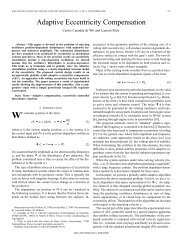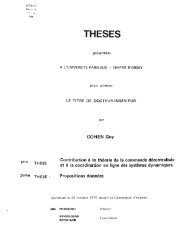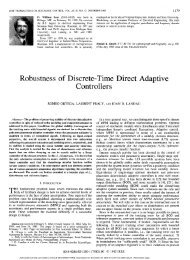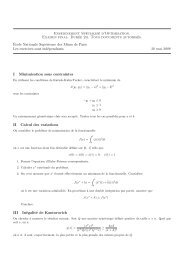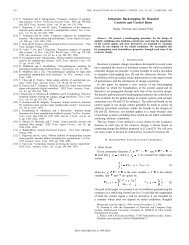HOMOGENEOUS OBSERVER DESIGN 1837Consequently, <strong>by</strong> Lemma 2.13, there ex<strong>is</strong>ts a positive real number c ∗ such that, for allc > c ∗ and all (ˆX n ,E 1 ) ≠ (0, 0), the Lyapunov function U, defined in (5.12), sat<strong>is</strong>fies∂U()∂ ˆX(ˆX n ,E 1 ) S n ˆXn + B n φ n (ˆX n )+K 1 (e 1 )n+ ∂U∂E 1(ˆX n ,E 1 )(E 1 )(S n E 1 + K 1 (e 1 )) < 0and the same holds for the homogeneous approximations in the 0-limit and in the∞-limit; hence the claim.Pro<strong>of</strong> <strong>of</strong> Corollary 5.2. We write the dynamics <strong>of</strong> the system (5.3) in the coordinatesˆX n and E 1 and in the time τ given in (5.8). Th<strong>is</strong> yields(5.13)with⎧⎪⎨⎪⎩ddτ ̂X n = S n ̂Xn + B n φ n (ˆX n )) + K 1 (e 1 ),ddτ E 1 = S n E 1 + K 1 (e 1 )+D(L)(δ1D(L) =L ,..., δ )nL n .We denote the solution <strong>of</strong> <strong>th<strong>is</strong></strong> system, starting from (̂X n (0),E 1 (0)) in R 2n at time τ,<strong>by</strong> (̂X τ,n (τ),E τ,1 (τ)). We have(5.14) x i (t) = L i−1 (ˆX τ,i (Lt) − e τ,i (Lt)) .The right-hand side <strong>of</strong> (5.13) <strong>is</strong> a vector field which <strong>is</strong> homogeneous in the bi-limitwith weights (r 0 ,r 0 ), (r ∞ ,r ∞ ) for (̂X n ,E 1 ) and (r 0 , r ∞ ) for D(L), where r 0,i = r 0,i +d 0and r ∞,i = r ∞,i + d ∞ for each i in {1,...,n}.The time function τ ↦→ δ( τ L) <strong>is</strong> considered as an input, and when D(L) = 0,Theorem 5.1 implies global asymptotic stability <strong>of</strong> the origin <strong>of</strong> the system (5.13)and <strong>of</strong> its homogeneous approximations. To complete the pro<strong>of</strong> we show that thereex<strong>is</strong>ts L ∗ such that the “input” D(L) sat<strong>is</strong>fies the small-gain condition (2.11) <strong>of</strong> Corollary2.22 for all L>L ∗ . Using (5.8) and (5.14), assumption (5.4) becomes, for all0 ≤ σ ≤ τ < LT and all i in {1,...,n},∣ δi( τL)∣ ∣L i{ (1 ∣∣∣z ( σ)∣ )∣∣≤ maxL i β τ − σδ , ,L L{i∑L −i ∣sup σ≤κ≤τ ∣L (j−1) (ˆX τ,j(κ) − e τ,j (κ)) ∣c 0j=11−d 0 (n−i−1)1−d 0 (n−j)i∑∣(5.15) + c ∞ ∣L (j−1) (ˆX τ,j(κ) − e τ,j (κ)) ∣Note that when 1 ≤ j ≤ i ≤ n, the function s ↦→ 1−(n−i−1) s1−(n−j) s<strong>is</strong> strictly increas-n−i) in (n+1−j , ij−1 ). As d 0 ≤ d ∞ < 1n−1, we have for all1ing, mapping (−1,1 ≤ j ≤ i ≤ n,n−1j=11−d∞(n−i−1)1−d∞(n−j)}}1 − d 0 (n − i − 1)1 − d 0 (n − j)≤ 1 − d ∞(n − i − 1)1 − d ∞ (n − j)
1838 V. ANDRIEU, L. PRALY, AND A. ASTOLFIHence, selecting L ≥ 1, there ex<strong>is</strong>ts a real number ɛ> 0 such thatL −ɛTh<strong>is</strong> implies∣ ( {∣δ τ i ∣(L)∣1 ∣∣∣z ( σ)∣ ∣∣L i ≤ maxL i β τ − σδ ,L L{i∑L −ɛ sup σ≤κ≤τOn the other hand, the function(̂X n ,E 1 ) ↦→ c 01−d∞(n−i−1)(j−1)≥ L1−d∞(n−j) −i ≥ L (j−1) 1−d 0 (n−i−1)1−d 0 (n−j) −i .i∑j=1c 0j=1),|(ˆX τ,j(κ) − e τ,j (κ))| 1−d 0 (n−i−1)1−d 0 (n−j)+ c ∞i∑j=1|ˆX j − e j | 1−d 0 (n−i−1)1−d 0 (n−j)+ c ∞i∑|(ˆX τ,j(κ) − e τ,j (κ))| 1−d∞(n−i−1)1−d∞(n−j)j=1|ˆX j − e j | 1−d∞(n−i−1)1−d∞(n−j)}}<strong>is</strong> homogeneous in the bi-limit with weights (r 0 ,r 0 ) and (r ∞ ,r ∞ ) and degrees 1 −d 0 (n − i − 1) = r 0,i + d 0 and 1 − d ∞ (n − i − 1) = r ∞,i + d ∞ (see (3.2)). Hence, <strong>by</strong>Corollary 2.15, there ex<strong>is</strong>ts a positive real number c 1 such thati∑c 0j=1|ˆX j − e j | 1−d 0 (n−i−1)1−d 0 (n−j)+ c ∞i∑j=1(5.16) ≤ c 1 H|ˆX j − e j | 1−d∞(n−i−1)1−d∞(n−j)()|(̂X n ,E 1 )| d0+r0,i(r , |(̂X 0,r 0) n ,E 1 )| d∞+r∞,i(r ∞,r ∞).Hence, <strong>by</strong> Corollary 2.22 (applied in the τ time-scale), there ex<strong>is</strong>ts c G such that forany L ∗ large enough such that c 1 L ∗−ε ≤ c G , the conclusion holds.Pro<strong>of</strong> <strong>of</strong> Corollary 5.3. The pro<strong>of</strong> <strong>is</strong> similar to the previous one with the onlydifference being that, when i and j sat<strong>is</strong>fy 3 ≤ i +2 ≤ j ≤ n, the function s ↦→1−(n−i−1) s1−(n−j) s<strong>is</strong> strictly decreasing, mapping (−1,1n−1 ) in ( icondition −1 < d ∞ ≤ d 0 < 1n−11 − d ∞ (n − i − 1)1 − d ∞ (n − j)gives the inequalities≥ 1 − d 0(n − i − 1)1 − d 0 (n − j)j−1 ,>n−in+1−jij − 1 .). Moreover theHence (5.16) holds, and <strong>by</strong> selecting L
- Page 1 and 2: SIAM J. CONTROL OPTIM.Vol. 47, No.
- Page 3 and 4: 1816 V. ANDRIEU, L. PRALY, AND A. A
- Page 5 and 6: 1818 V. ANDRIEU, L. PRALY, AND A. A
- Page 7 and 8: 1820 V. ANDRIEU, L. PRALY, AND A. A
- Page 9 and 10: 1822 V. ANDRIEU, L. PRALY, AND A. A
- Page 11 and 12: 1824 V. ANDRIEU, L. PRALY, AND A. A
- Page 13 and 14: 1826 V. ANDRIEU, L. PRALY, AND A. A
- Page 15 and 16: 1828 V. ANDRIEU, L. PRALY, AND A. A
- Page 17 and 18: 1830 V. ANDRIEU, L. PRALY, AND A. A
- Page 19 and 20: 1832 V. ANDRIEU, L. PRALY, AND A. A
- Page 21 and 22: 1834 V. ANDRIEU, L. PRALY, AND A. A
- Page 23: 1836 V. ANDRIEU, L. PRALY, AND A. A
- Page 27 and 28: 1840 V. ANDRIEU, L. PRALY, AND A. A
- Page 29 and 30: 1842 V. ANDRIEU, L. PRALY, AND A. A
- Page 31 and 32: 1844 V. ANDRIEU, L. PRALY, AND A. A
- Page 33 and 34: 1846 V. ANDRIEU, L. PRALY, AND A. A
- Page 35 and 36: 1848 V. ANDRIEU, L. PRALY, AND A. A
- Page 37: 1850 V. ANDRIEU, L. PRALY, AND A. A




